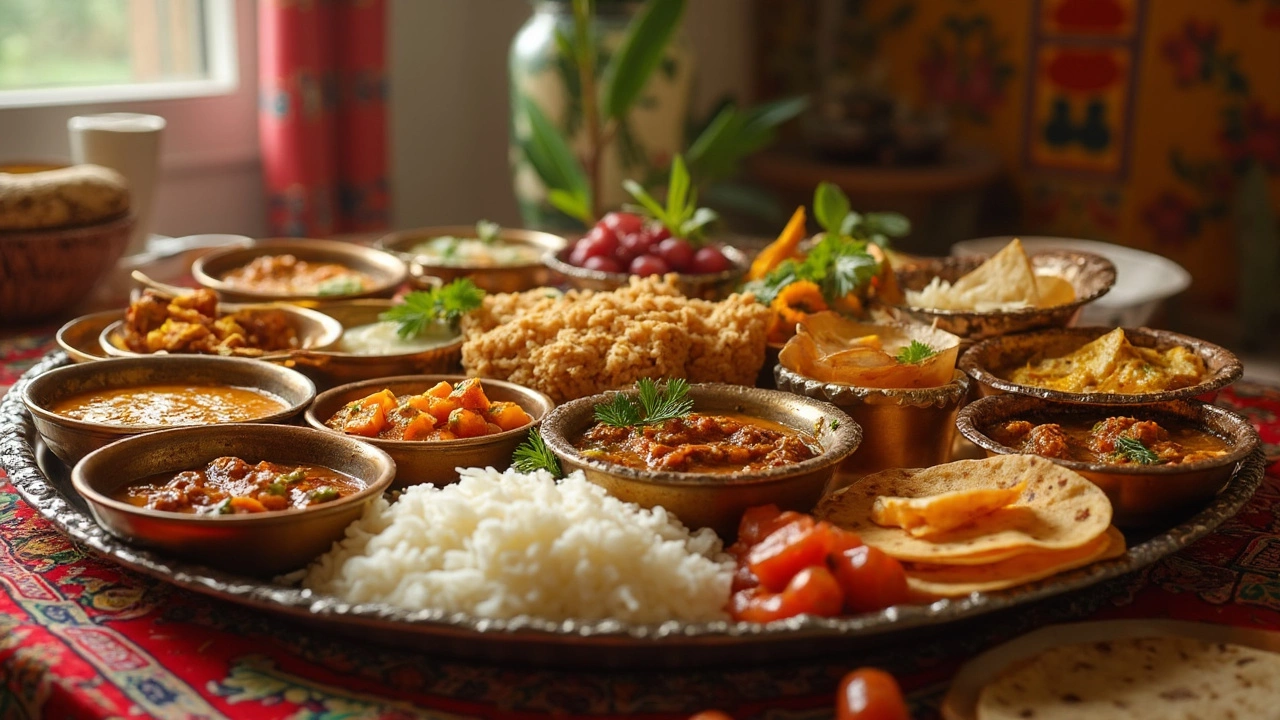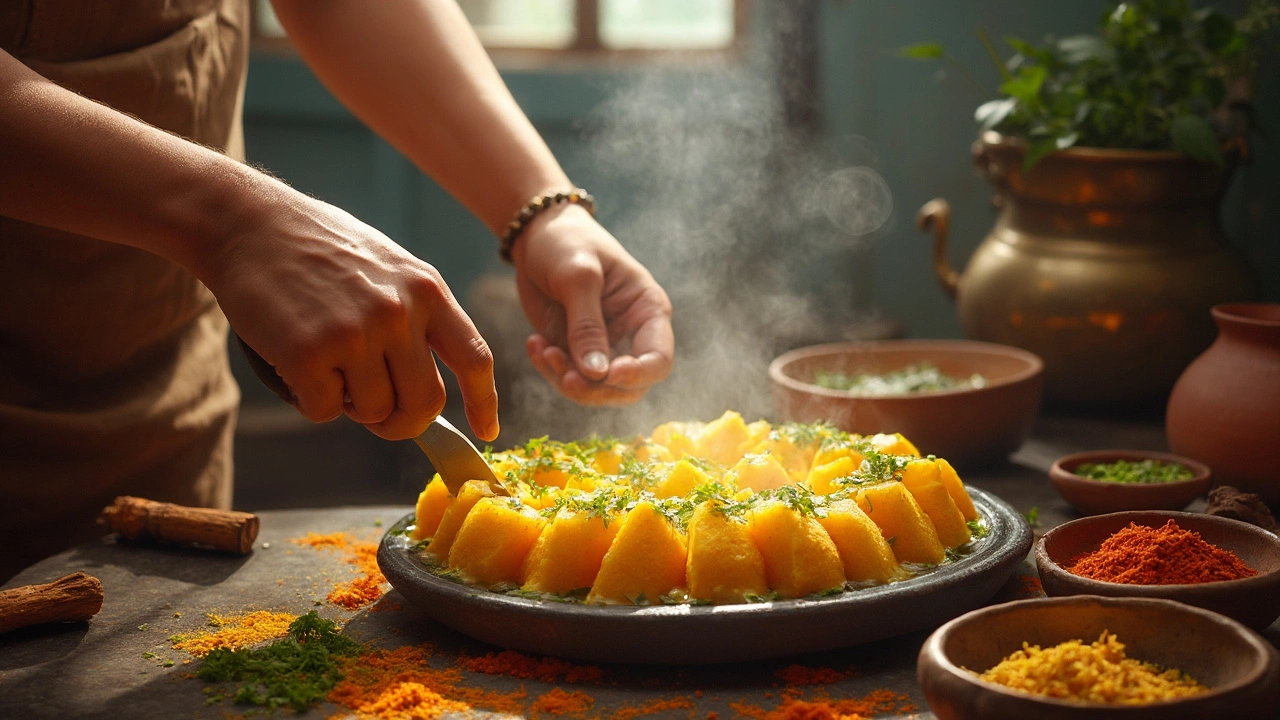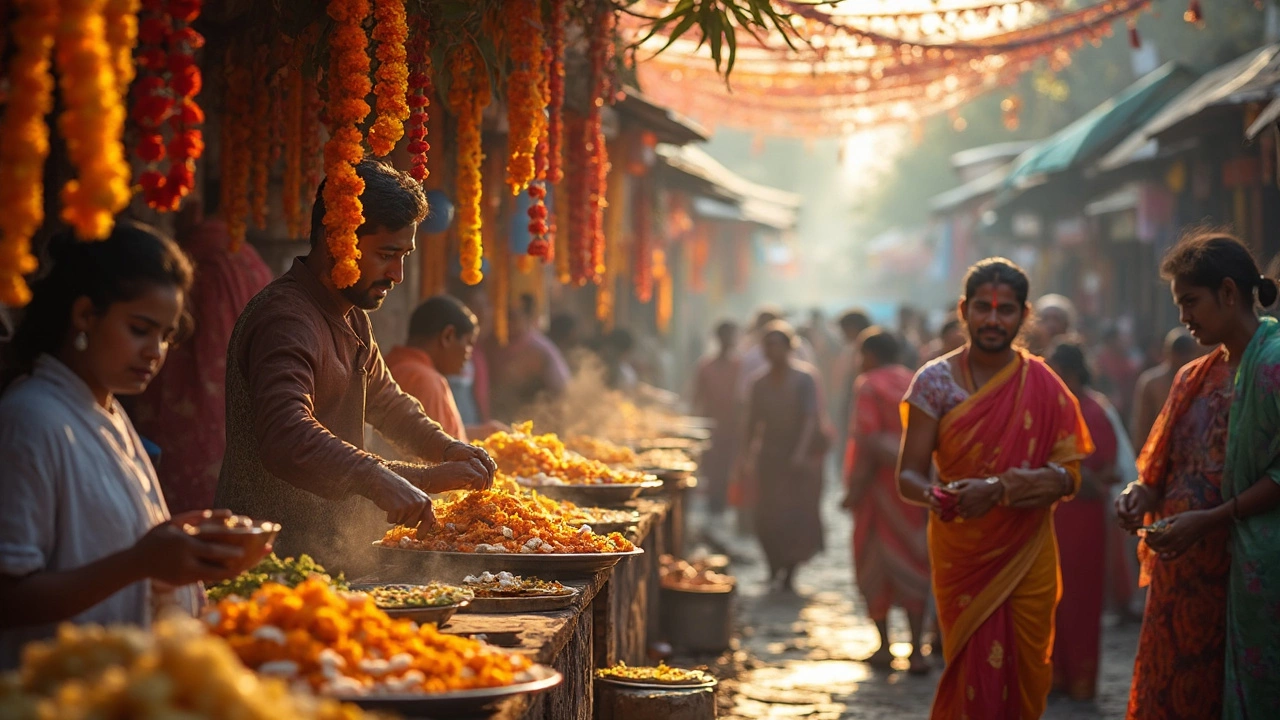If you ask anybody what Gujarat is best known for, there’s a good chance food will pop up in the conversation. Living in India, you can't escape the influence of Gujarati snacks at tea stalls, weddings, or even train journeys. Dhokla, fafda, khandvi—these crunchy, spongy, and just-sweet-enough foods are hard to ignore, right?
What makes Gujarati cuisine different is this sly balance between sweet, spicy, and tangy in almost every dish. You bite into something that looks simple and suddenly get hit with flavors that keep changing as you chew. There’s always that touch of sweetness, even in the most common sabzis or curries. It’s not by accident—most Gujaratis prefer their food with a bit of jaggery or sugar, which you’ll notice in everything, from their dal to their snacks.
You won’t just find all this inside homes or fancy restaurants. Gujarat’s street food is an adventure by itself. Food stalls grilling bhakri, vendors dishing out steaming undhiyu during winter, and city corners loaded with snacks you might never have tasted before. It’s never boring, and there’s always something new to try, no matter how many times you visit.
- Signature Gujarati Dishes
- The Art of the Gujarati Thali
- Street Food Wonders
- Festivals and Food Traditions
- Where to Find Authentic Gujarati Food
Signature Gujarati Dishes
If there's one thing that puts Gujarati food on the culinary map, it's the amazing line-up of snacks and home-style dishes. The classics don't just taste good—they have stories, traditions, and even their own time slots during the day!
Let’s get real about the dishes everyone talks about:
- Dhokla: This spongy, yellow steamed cake is made with fermented rice and chickpea flour. It's soft, slightly sweet, and has a gentle tang. Usually eaten for breakfast or as a snack, it's topped with mustard seeds and coriander. Look out for varieties like Khaman and Nylon Dhokla.
- Fafda and Jalebi: Sunday mornings in Gujarat aren’t complete without this combo. Fafda is a crunchy, fried gram flour strip, paired best with sweet, syrupy jalebi and a side of spicy chutney.
- Khandvi: Made from chickpea flour and yogurt, khandvi is rolled up into tiny, yellow pinwheels seasoned with sesame seeds, mustard, and coconut. Light on the stomach, but packed with flavor.
- Thepla: If you spot someone on a train with rolled-up flatbreads wrapped in foil, it's almost definitely thepla. This spiced wheat flatbread loaded with fenugreek leaves is a travel staple thanks to its long shelf life.
- Undhiyu: This one is a showstopper. Served mostly in winter, Undhiyu is a mixed veg curry with yam, potatoes, green beans, eggplant, and methi muthia, slow-cooked upside down in an earthen pot. It’s a must during Uttarayan (kite festival) and takes hours to prepare right.
- Handvo: Think of it as a savory cake made from rice, lentils, bottle gourd, and a kick of spices. Handvo is baked and gets a crunchy layer thanks to sesame seeds on top.
- Sev Tameta nu Shaak: This sweet and tangy tomato curry is topped with crunchy gram flour sev. It’s fast to whip up and comforting on a rainy evening with hot rotis.
Gujarati food isn’t only about snacks. Everyday staples like dal-dhokli—sort of a pasta-in-dal comfort dish—make regular appearances in homes. There are also dozens of sweets to try, but mohanthal and shrikhand are always front runners during festivals.
Nearly every city has its twist on these foods, but you'll notice the typical balance of flavors—where sweet, spicy, and tangy come together in unexpected ways. Thanks to this, Gujarati cuisine is instantly recognizable anywhere in India.
| Dish | Main Ingredient | Common Time Served |
|---|---|---|
| Dhokla | Rice & Chickpea flour | Breakfast/Snack |
| Thepla | Wheat & Fenugreek | Travel/Meal |
| Undhiyu | Mixed Vegetables | Winter |
| Khandvi | Chickpea flour & Yogurt | Snack |
Curious where to try these? Local mithai shops, snack centers, and thali restaurants will have at least a few of these classics fresh and ready. If you ever get invited to a Gujarati home, don’t miss out!
The Art of the Gujarati Thali
If there’s one thing that shows off Gujarati cuisine in full color, it’s the Gujarati thali. ‘Thali’ doesn’t just mean a plate—it’s a full-meal experience, loaded with small servings of all the flavors Gujarat loves. Walk into any traditional Gujarati restaurant, and the waiters will circle your table, refilling your plate till you signal surrender.
What lands on a thali? You’ll spot a typical rotation of:
- Dal or kadhi (yogurt-based curry, lightly spiced and just a bit sweet)
- Two or three types of sabzi (veg curries, usually one dry and one with gravy)
- Roti, puris, or thepla
- Rice or khichdi
- Farsan (snacks like dhokla or khandvi)
- Chutneys and pickles—always a couple for that tangy kick
- Sweets—could be shrikhand, basundi, or just a simple piece of jaggery
- Salad and papadum for crunch
The cool part? The order and the dishes keep changing depending on region and season. In Ahmedabad, you might find undhiyu and aamras in the mix, while in Saurashtra, they’ll never skip on the garlic chutney. During summer, keri no ras (fresh mango pulp) becomes a must-have.
There’s even a method to the madness. Traditionally, the thali starts you off with mild tastes and slowly builds up to spicier curries and crunchy sides, letting your palate adjust along the way. Sweets work as palate cleansers—so you’ll often see people taking bites of dessert in the middle of the meal, not just at the end.
| Element | Common Ingredient | Unique Touch |
|---|---|---|
| Dal/Kadhi | Pigeon peas, yogurt | Sugar or jaggery added |
| Farsan | Chickpea flour | Steamed or fried, always light |
| Sweets | Milk, cardamom, saffron | Served with the meal, not after |
If you’re sampling a Gujarati thali for the first time, pace yourself. It’s meant to be leisurely, savored bite by bite. Locals say the best way is to eat a little of everything, mixing and matching the flavors.
And here’s a pro tip: finish with a glass of chaas (buttermilk). It helps you cool off after the spice and makes you feel like you actually have room for dessert… even if you don’t.

Street Food Wonders
Ask anyone from Ahmedabad or Surat about their evenings, and you'll probably hear tales about late-night stops at bustling food stalls. Gujarat isn’t just famous for home-cooked food; its street food scene is legendary across India. If you love spicy, sweet, and crunchy bites, this is prime territory.
Let’s start with khaman and dhokla. These light, fluffy snacks are go-to options at nearly every stall. Khaman is a lot like the famous dhokla, but it’s softer, spongier, and sometimes topped with fiery green chilies. If you’re in Surat, Locho is a must-try—a steamed snack made from gram flour and served with extra sev, onions, and green chutney.
Fafda and jalebi? Classic combo. Fafda’s crunch and jalebi’s syrupy sweetness have been fueling Sunday mornings and festival breakfasts for decades. This isn’t just hype. According to the Times of India:
“On Dussehra each year, demand for Fafda and Jalebi in Gujarat reaches close to 800 tonnes, proving their unbeatable status in local street food culture.”
Then there’s the stuff you don’t see everywhere—like Ganthiya, a thicker, softer version of sev, or Handvo, a savory cake full of lentils and veggies. Khandvi, those neat, yellow rolls you see stacked up behind glass, come topped with mustard seeds and coconut. Not only are they tasty, but they’re also light on the stomach—perfect on a hot day.
- Sev Usal: A spicy curry loaded with peas, topped with crunchy sev and onions. Popular in Vadodara.
- Pav Bhaji: Yes, it's pan-Indian, but the Gujarati twist often includes a dash of sweetness and a softer bun.
- Bhajiya: Think of them as battered, deep-fried veggies—mainly sold at roadside carts when it rains.
If you’re looking for where to start, Manek Chowk in Ahmedabad transforms into a street food paradise after dark. You’ll get everything from local pizza versions to traditional sweets right under one roof.
| City | Popular Street Food |
|---|---|
| Ahmedabad | Khaman, Handvo, Maskabun |
| Surat | Locho, Ghari, Undhiyu |
| Vadodara | Sev Usal, Bhajiya, Farsan |
| Rajkot | Dhokla, Ganthiya, Samosa |
Don’t forget to carry some cash—they still prefer it at most stalls. And go early if you want the best picks. By 10 pm, that fresh khandvi and jalebi will be long gone!
Festivals and Food Traditions
If you’ve ever celebrated a festival in Gujarat, you know it’s not just about rituals—it’s about what’s on the plate. Every festival comes with its own set of must-have Gujarati food and treats, and no two menus are the same.
Take Uttarayan (the kite festival) as an example. The sky’s full of kites and everyone's munching on chikki (a crunchy peanut brittle), jalebi, and undhiyu. Undhiyu is a mixed-veg dish slow-cooked with root veggies, beans, and methi muthiya (fenugreek dumplings). This dish only comes out during winter, when the ingredients are fresh. It’s so iconic for this time of year, some families skip lunch and go straight in for a hearty undhiyu brunch.
During Navratri, it’s not just about dancing the garba all night. People swear by lighter foods and snacks like sabudana khichdi, farali chevdo, and singhada (water chestnut) flour puris. These dishes skip grains but still burst with flavor. And trust me, if you’re fasting, you won’t feel like you’re missing out on taste at all.
Diwali is when kitchens in Gujarat go into overdrive. The list of homemade sweets and snacks is never ending: ghughra (sweet stuffed pastries), chorafali, chakri, mohanthal, and sev. Households still come together to make these from scratch, passing recipes down like family valuables. It’s the best time to swap snacks with neighbors and show off your version of traditional recipes.
- Uttarayan: Chikki, undhiyu, jalebi
- Navratri: Sabudana khichdi, farali chevdo, singhada puri
- Diwali: Ghughra, chakri, mohanthal, sev, chorafali
There are even lesser-known traditions, like “Sitla Satam,” when homes cook food a day in advance and then only eat it cold the next day—no stoves allowed. This isn’t just for tradition’s sake. It actually helps families to rest up before big festivals, and the simple, cold dishes taste surprisingly good in Gujarat’s heat.
Gujarat’s festivals aren’t complete without these tasty customs. No wonder Gujarati cuisine keeps popping up in any chat about celebrations. The food isn’t just fuel—it’s how people remember and share the fun.

Where to Find Authentic Gujarati Food
Trying to find real Gujarati food isn’t tough if you know where to look. While you get a taste in any big city, the local joints in Gujarat are a whole different level. Cities like Ahmedabad, Surat, and Vadodara are packed with family-owned restaurants, age-old sweet shops, and street food stalls that locals swear by.
If you want the whole experience, Gujarati thali restaurants are your best bet. Spots like Agashiye in Ahmedabad serve unlimited thalis with everything—from dal, kadhi, and undhiyu to every kind of papad and chutney you can think of. People line up for lunch, and trust me, nobody leaves hungry.
Outside Gujarat, it’s smart to find areas with a Gujarati community. In Mumbai, visit Soam or Swati Snacks for classics like khichu and khandvi. Even in London or New Jersey, Gujarati-run canteens stay true to home-style flavor. Always look for a menu loaded with dhokla, farsan, and sweets like shrikhand or mohanthal.
If you want something more casual, just roam the street markets. Here’s a quick list of famous places for authentic Gujarati cuisine:
- Manek Chowk, Ahmedabad – best late-night snacks and desserts
- Gordhan Thal, Ahmedabad – famous for their royal thali spread
- Jalaram Khichdi, Rajkot – everything khichdi with a Gujarati twist
- Gopal Locho, Surat – unbeatable for Surati locho
- Dumas Beach, Surat – street vendors selling everything from bhajia to sweet corn
According to a 2023 survey by the Gujarat Tourism Board, nearly 67% of tourists in the state list food as their main reason for visiting. Here’s a quick look at the top tourist food picks, based on that survey:
| City | Most Popular Dish |
|---|---|
| Ahmedabad | Dhokla and Thali |
| Surat | Locho and Surti Undhiyu |
| Vadodara | Sev Usal |
| Rajkot | Khichdi-Kadhi |
If you want to recreate the experience at home, lots of neighborhoods in India have Gujarati groceries. Pick up fresh fafda, thepla, or gathiya, warm them up, and have them with chai. It’s the next best thing to being there.
